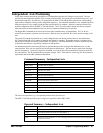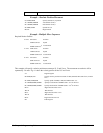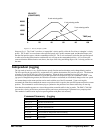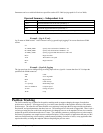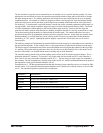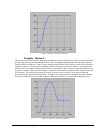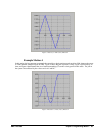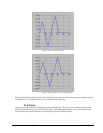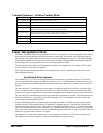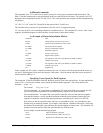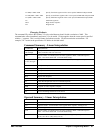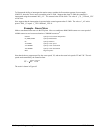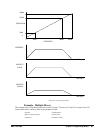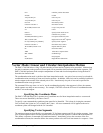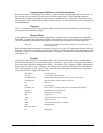
DMC-1700/1800 Chapter 6 Programming Motion • 95
Command Summary – Position Tracking Mode
COMMAND DESCRIPTION
AC n,n,n,n,n,n,n,n Acceleration settings for the specified axes
AP n,n,n,n,n,n,n,n Trip point that holds up program execution until an absolute position has been reached
DC n,n,n,n,n,n,n,n Deceleration settings for the specified axes
MF n,n,n,n,n,n,n,n
Trip point to hold up program execution until n number of counts have passed in the
forward direction. Only one axis at a time may be specified.
MR n,n,n,n,n,n,n,n
Trip point to hold up program execution until n number of counts have passed in the
reverse direction. Only one axis at a time may be specified.
PT n,n,n,n,n,n,n,n Command used to enter and exit the Trajectory Modification Mode
PA n,n,n,n,n,n,n,n Command Used to specify the absolute position target
SP n,n,n,n,n,n,n,n Command used to enter and exit the Trajectory Modification Mode
Linear Interpolation Mode
The DMC-1700/1800 provides a linear interpolation mode for 2 or more axes. In linear interpolation mode, motion
between the axes is coordinated to maintain the prescribed vector
speed, acceleration, and deceleration along the
specified path. The motion path is described in terms of incremental distances for each axis. An unlimited number
of incremental segments may be given in a continuous move sequence, making the linear interpolation mode ideal
for following a piece-wise linear path. There is no limit to the total move length.
The LM command selects the Linear Interpolation mode and axes for interpolation. For example, LM YZ selects
only the Y and Z axes for linear interpolation.
When using the linear interpolation mode, the LM command only needs to be specified once unless the axes for
linear interpolation change.
Specifying Linear Segments
The command LI x,y,z,w or LI a,b,c,d,e,f,g,h specifies the incremental move distance for each axis. This means
motion is prescribed with respect to the current axis position. Up to 511 incremental move segments may be given
prior to the Begin Sequence (BGS) command. Once motion has begun, additional LI segments may be sent to the
controller.
The clear sequence (CS) command can be used to remove LI segments stored in the buffer prior to the start of the
motion. To stop the motion, use the instructions STS or AB. The command, ST, causes a decelerated stop. The
command, AB, causes an instantaneous stop and aborts the program, and the command AB1 aborts the motion only.
The Linear End (LE) command must be used to specify the end of a linear move sequence. This command tells the
controller to decelerate to a stop following the last LI command. If an LE command is not given, an Abort AB1
must be used to abort the motion sequence.
It is the responsibility of the user to keep enough LI segments in the DMC-1700/1800 sequence buffer to ensure
continuous motion. If the controller receives no additional LI segments and no LE command, the controller will
stop motion instantly at the last vector. There will be no controlled deceleration. LM? or _LM returns the available
spaces for LI segments that can be sent to the buffer. 511 returned means the buffer is empty and 511 LI segments
can be sent. A zero means the buffer is full and no additional segments can be sent. As long as the buffer is not full,
additional LI segments can be sent at PC bus speeds.
The instruction _CS returns the segment counter. As the segments are processed, _CS increases, starting at zero.
This function allows the host computer to determine which segment is being processed.



